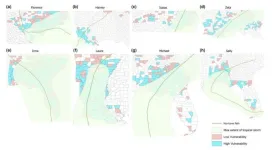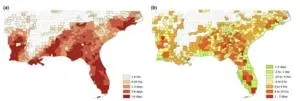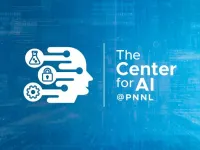(Press-News.org) Hurricanes and other extreme weather events often affect disadvantaged communities more severely, and extended power outages are some of the most harmful effects. Concerns over the intensification of hurricanes has led to new environmental justice policies that aim to mitigate the unequal impacts of major storms. Now, policy experts and engineers are directing their attention toward illuminating the causes.
Researchers at the Georgia Institute of Technology sought to investigate whether socioeconomically vulnerable households experienced longer power outage durations after extreme weather events. The team analyzed data from the top eight major Atlantic hurricanes between 2017 and 2020 that knocked out power for over 15 million customers in nine states across the southeastern U.S. The team found that people in lower socioeconomic tiers wait significantly longer to have power restored after a major storm — nearly three hours longer on average.
The interdisciplinary research team consists of Chuanyi Ji, an associate professor in the School of Electrical and Computer Engineering; Scott Ganz, a policy researcher at Georgetown University and a former Georgia Tech faculty member; and Chenghao Duan, a Ph.D. student in Ji’s lab.
Their research paper, titled “Socioeconomic Vulnerability and Differential Impact of Severe Weather-Induced Power Outages,” was published in the journal PNAS Nexus.
“Not only do extreme weather events impact disadvantaged communities more harshly, but power disruption can be dangerous and even life-threatening in certain contexts,” Ji said. “Those with fewer resources are limited in their ability to evacuate from severe weather situations, and for individuals with electric medical equipment, an extended power outage can be disastrous.”
Ji, who specializes in large-scale data analytics for power grid resilience, has done previous work on power restoration procedures involving infrastructure and utility services, but wanted to expand the work into the realm of communities. The team hypothesized that disadvantaged communities likely wait longer for power to be restored, but to get a realistic picture of the mechanisms at play, the team needed to analyze troves of data.
They obtained weather data for eight major hurricanes between 2017 and 2020 from the National Oceanic and Atmospheric Administration and additional flood databases. They also examined power failure data for 15 million customers for the same time period, which spanned nine states, 588 counties, and 108 utility service regions in the Southeast.
The team used spatial data analytics to model weather impact across regions. They then measured customers’ socioeconomic status by using the social vulnerability index, a tool produced by the Centers for Disease Control that considers indicators related to poverty, housing costs, education, health insurance, and other factors to determine socioeconomic status. Duan and Ji designed the models and estimates, and then analyzed the results to reveal the underlying relationship between customers' socioeconomic status and their power outage durations.
Their results show that, when comparing affluent communities and poor communities given the same kind of impact from weather events, poor communities experienced power outages that average 170 minutes longer. Specifically, they found that a one-decile drop in socioeconomic status is associated with a 6.1% longer outage duration. Their results indicate that there is a statistically significant relationship between socioeconomic vulnerability and the duration of time that elapses before power is restored.
“Our study also tries to rule out some possible explanations for why socioeconomically disadvantaged people take longer to get their power back on,” Ganz said. “For example, our study controls for population density in a county and the peak number of outages in that county, and we still observe that socioeconomically disadvantaged communities experience longer outages.”
He theorized that the “primary cause is that poorer communities are also likely to be more distant from critical infrastructure or require more significant repairs to power lines, but these are important questions for future research.”
The results can have important implications for policymakers, pointing to the necessity of reexamining post-storm recovery and resource allocation policies. Service and utility providers approach power recovery by adhering to procedures and regulations that are policy-driven. Current research shows that the standard procedures for restoring power following big storms, while procedurally fair, may contribute to unequal outcomes. A greater focus on communities could help to correct the issue.
“Power grid resilience is not just about the infrastructure and utility companies — it’s also about the people they serve,” Ji said. “Success in achieving policy goals depends on our ability to identify the features that contribute most to these unequal impacts, which can in turn help us design appropriate interventions to improve outcomes.”
Citation: Scott C Ganz, Chenghao Duan, Chuanyi Ji, Socioeconomic vulnerability and differential impact of severe weather-induced power outages, PNAS Nexus, Volume 2, Issue 10, October 2023.
DOI: https://doi.org/10.1093/pnasnexus/pgad295
Writer: Catherine Barzler
#####
The Georgia Institute of Technology, or Georgia Tech, is one of the top public research universities in the U.S., developing leaders who advance technology and improve the human condition. The Institute offers business, computing, design, engineering, liberal arts, and sciences degrees. Its more than 45,000 undergraduate and graduate students, representing 50 states and more than 148 countries, study at the main campus in Atlanta, at campuses in France and China, and through distance and online learning. As a leading technological university, Georgia Tech is an engine of economic development for Georgia, the Southeast, and the nation, conducting more than $1 billion in research annually for government, industry, and society.
END
Research shows disadvantaged people wait significantly longer for power restoration after major storms
The team found that people in lower socioeconomic tiers wait nearly three hours longer for power restoration after major storms
2023-12-14
ELSE PRESS RELEASES FROM THIS DATE:
PNNL creates Center for Artificial Intelligence
2023-12-14
RICHLAND, Wash.—The Department of Energy’s Pacific Northwest National Laboratory has created the Center for AI @PNNL to coordinate the pioneering research of hundreds of scientists working on a range of projects focused on science, security and energy resilience.
Researchers at PNNL were among the first to dive into artificial intelligence decades ago. But AI has surged in the past year with the ready availability of generative AI, which allows almost anyone to produce sophisticated—though sometimes errant—text and images with just a small amount of data. At the same time, AI is a vital tool for ...
Photonics research reveals potential for next-gen AR/VR and IoT
2023-12-14
USD$200,000 awarded to tackle today’s pressing consumer technology demands
Utilizing smart optical sensors for IoT
Providing more realistic virtual and augmented realities
WASHINGTON – The Optica Foundation today released more detailed information on information technology research funded by the 2023 Optica Foundation Challenge. Researchers Zaijun Chen, University of Southern California, USA, and Alejandro Velez-Zea, Universidad de Antioquia, Colombia, both proposed novel approaches to addressing the flow of data and information in consumer-centric technologies.
“The ...
Jurors recommend death penalty based on looks, but new training can correct the bias
2023-12-14
Certain facial features—like downturned lips and a heavy brow—are known to make someone appear untrustworthy to others, even though these do not indicate a person’s actual character. Such facial biases influence our everyday social interactions as well as high-stakes decisions, including who we hire, or elect to political office.
But a new study by Columbia researchers shows that the effects of these judgments can be mitigated. The study outlines the results of four experiments that the authors conducted with 1,400 volunteers. Through those experiments, the researchers found that when real-world defendants have facial features that appear untrustworthy, they are more likely ...
Closing the design-to-manufacturing gap for optical devices
2023-12-14
Photolithography involves manipulating light to precisely etch features onto a surface, and is commonly used to fabricate computer chips and optical devices like lenses. But tiny deviations during the manufacturing process often cause these devices to fall short of their designers’ intentions.
To help close this design-to-manufacturing gap, researchers from MIT and the Chinese University of Hong Kong used machine learning to build a digital simulator that mimics a specific photolithography manufacturing process. Their technique utilizes real data gathered from the photolithography system, so it can more ...
Seals stay warm and hydrated in the arctic with larger, more convoluted nasal passages
2023-12-14
Arctic seals have evolved many adaptations to cope with their frosty environment—one that you might not immediately think of is the bones in their nasal cavity. Arctic seals have more convoluted nasal passages than seal species that live in milder environments, and researchers report December 14 in the Biophysical Journal that these structures help the seals more efficiently retain heat and moisture as they breathe in and out.
“Thanks to this elaborate structure in their nasal cavities, Arctic seals lose less heat through nasal heat exchange than subtropical seals when both are exposed to the same ...
D-mannose reduces age-triggered changes in urinary tract that increase susceptibility to UTIs
2023-12-14
Aging poses a number of challenges to the body’s well-being, one of the most important being an increased susceptibility to multiple diseases, including urinary tract infections (UTIs). The connection between aging and more prevalent UTIs is not well understood, but now researchers at Baylor College of Medicine have found an explanation.
The researchers show in the journal Developmental Cell that, compared to the younger counterpart, the aging urinary tract in animal models changes how it functions at the cellular level in ways that seem to favor the establishment ...
Where patients live impacts whether they pick up their heart-failure medications
2023-12-14
People who live in neighborhoods with higher levels of poverty and unemployment are less likely to fill their heart-failure drug prescriptions than those living in wealthier areas, a new study shows. The findings not only add to understanding geographic and economic disparities in heart disease care, but also point to new ways to address barriers for patients taking these lifesaving drugs.
Led by researchers at NYU Grossman School of Medicine, the study explored prescription pickup patterns among patients with systolic heart failure, a chronic, life-threatening ...
Animal behavior: Cats like to fetch when they’re feline playful
2023-12-14
Cats tend to dictate games of fetch with their owners and most cats who play fetch learned to do so without explicit training, according to a survey of 924 cat owners published in Scientific Reports. The findings also highlight the variety of objects that cats prefer to fetch, including hair ties and bottle parts.
Jemma Forman, Elizabeth Renner and David Leavens surveyed cat owners who reported fetching behaviours in 1,154 cats that they currently or previously owned. Owners reported how fetching first occurred, how often it occurs ...
New understanding of ancient genetic parasite may spur medical breakthroughs
2023-12-14
A multidisciplinary study published in Nature has elucidated the structure of the machinery responsible for writing much of our “dark genome” — the 98 percent of our DNA that has largely unknown biological function. These results may spur entirely novel treatments for autoimmune diseases, cancer and neurodegeneration.
An international team of scientists from Rutgers and more than a dozen other institutions, including both academia and industry, have published the first high-resolution images and structural details of avirus-like element known as LINE-1. They describe it as “an ancient genetic parasite” that is one of the most common parts of human DNA (video ...
Neighborhood-level socioeconomic status and prescription fill patterns among patients with heart failure
2023-12-14
About The Study: In this study of 6,247 patients with heart failure with reduced ejection fraction, patients living in neighborhoods with lower neighborhood-level socioeconomic status had significantly higher odds of nonadherence to guideline-directed medical therapy. These findings highlight the importance of considering neighborhood-level disparities when developing approaches to improve medication adherence.
Authors: Amrita Mukhopadhyay, M.D., of the NYU Grossman School of Medicine in New York, is the corresponding ...
LAST 30 PRESS RELEASES:
Making lighter work of calculating fluid and heat flow
Normalizing blood sugar can halve heart attack risk
Lowering blood sugar cuts heart attack risk in people with prediabetes
Study links genetic variants to risk of blinding eye disease in premature infants
Non-opioid ‘pain sponge’ therapy halts cartilage degeneration and relieves chronic pain
AI can pick up cultural values by mimicking how kids learn
China’s ecological redlines offer fast track to 30 x 30 global conservation goal
Invisible indoor threats: emerging household contaminants and their growing risks to human health
Adding antibody treatment to chemo boosts outcomes for children with rare cancer
Germline pathogenic variants among women without a history of breast cancer
Tanning beds triple melanoma risk, potentially causing broad DNA damage
Unique bond identified as key to viral infection speed
Indoor tanning makes youthful skin much older on a genetic level
Mouse model sheds new light on the causes and potential solutions to human GI problems linked to muscular dystrophy
The Journal of Nuclear Medicine ahead-of-print tip sheet: December 12, 2025
Smarter tools for peering into the microscopic world
Applications open for funding to conduct research in the Kinsey Institute archives
Global measure underestimates the severity of food insecurity
Child survivors of critical illness are missing out on timely follow up care
Risk-based vs annual breast cancer screening / the WISDOM randomized clinical trial
University of Toronto launches Electric Vehicle Innovation Ontario to accelerate advanced EV technologies and build Canada’s innovation advantage
Early relapse predicts poor outcomes in aggressive blood cancer
American College of Lifestyle Medicine applauds two CMS models aligned with lifestyle medicine practice and reimbursement
Clinical trial finds cannabis use not a barrier to quitting nicotine vaping
Supplemental nutrition assistance program policies and food insecurity
Switching immune cells to “night mode” could limit damage after a heart attack, study suggests
URI-based Global RIghts Project report spotlights continued troubling trends in worldwide inhumane treatment
Neutrophils are less aggressive at night, explaining why nighttime heart attacks cause less damage than daytime events
Menopausal hormone therapy may not pose breast cancer risk for women with BRCA mutations
Mobile health tool may improve quality of life for adolescent and young adult breast cancer survivors
[Press-News.org] Research shows disadvantaged people wait significantly longer for power restoration after major stormsThe team found that people in lower socioeconomic tiers wait nearly three hours longer for power restoration after major storms





